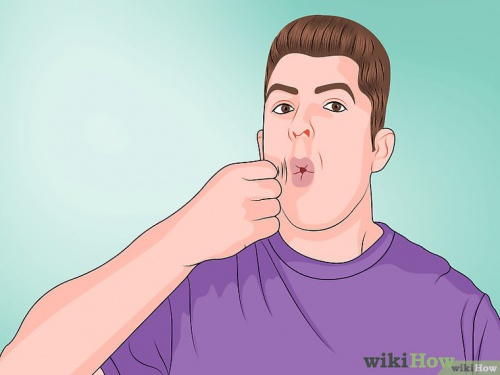Make a Water Drop Sound With Your Mouth
You can learn to imitate the sound of a water droplet hitting a lake, using only your mouth and hands. This can take a lot of practice to pull off, but since you won't need any tools you can put in the effort in bits and pieces, whenever you have a couple minutes free.
Contents
Steps
Making a Water Drop Sound with Your Mouth
- Wet your lips. Drink a glass or two of water if your lips are dry, and whenever you need to while practicing. Apply lip balm and try again later if they're severely chapped.
- Whistle. Whistling involves the same mouth shape, and may be easier to learn. If you can't whistle, pucker your lips slightly with a gap between them for air to pass through. Pull your tongue back.
- Pull your lower jaw downward to stretch out your cheeks and give yourself more air to work with.
- Hold your breath. You can't make the water drop sound while blowing or breathing through your nose. Get in the habit of breathing through your nose while practicing.
- Practice mouthing the word "hoink." Practice this for at least five or ten minutes. Say the word "hoink" repeatedly, then repeat that same mouth motion without vocalizing or grunting. Move your jaw and Adam's apple quickly upward as you do this, and move your tongue up and forward.
- You should feel a short flow of air leave your mouth while you say this, even though you aren't exhaling.
- If you know Russian, a certain vulgar three-letter word beginning with Х works even better.
- Tap or flick your cheek during the mouth movement. Repeat the "hoink" mouth movement. Right before you finish the tongue movement, tap the outside of your cheek with your finger. Flicking your cheek will work instead, and may help get a louder sound when you're first practicing, but you're striking too hard if you give yourself a red, stinging cheek.
- Some people find it easier to tap with the eraser end of a pencil, instead of a finger.
- This step often takes 45 minutes of dedicated practice, and can take days if you practice only occasionally.
- You can also try tapping the hollow between your teeth, the back of your lower jaw, the side of your front eyetooth, and anywhere in between.
Troubleshooting
- Learn the mouth shape even if you can't whistle. This trick is much easier to learn if you can whistle, but that doesn't mean you can't do it. To make the right mouth shape, purse your lips together by drawing in the corners of your mouth slightly. Don't overdo it and make a "duck face." Your lips should only stick out slightly, with a gap in between them for air to pass through.
- Relax if your muscles are sore. If your jaw or cheeks are getting tense, you've lowered your jaw too far. If your cheek is red and stinging, you're flicking it too hard. No part of this process should feel painful or uncomfortable.
- If you're sore simply from practicing for a long stretch of time, take a ten minute break.
- Prevent yourself from exhaling. If you keep forgetting not to blow during your practice, inhale through your nose, and the passageway at the back of your mouth should automatically close shut.
- Wait for the flow of air during the hoink motion. If you can't get the sound within five minutes of flicking, stop and focus just on the hoink motion. Pay attention to the air flowing past your lips. If you don't feel it, try moving your tongue or jaw and trying again. Once you notice a brief flow of air, as though you were blowing gently, start flicking again and try to flick at the same time as that flow.
- If you're lucky, you might even here a hollow whistling sound or even a faint water drop noise without the flick – then you're definitely on the right track.
Tips
- If your cheeks get tense or sore, take a break or rub them to relax them again. Cold cheeks can also stiffen up and impede you.
- Once you manage to make the sound, try amplifying it by clapping in front of your mouth. First, with your lips pursed, place one thumb on each cheek, and clap in front of your lips. Move your clapping hands up and down until you feel them direct a blast of air onto your lips. Repeat that clap when you would normally flick your cheek.
- More difficult methods to make this sound include flicking the underside of your jaw instead, or even lightly thumping the back or top of your head. With enough practice, some people can dislodge the air through mouth movements alone.
Related Articles
- Blow Saliva Bubbles
- Make a Smack Pack Noise
- Cross One Eye at a Time
- Burp on Demand
- Make Sound with Water
Sources and Citations
- http://www.northernnightingale.com/lessons.html
- http://www.reddit.com/r/LearnUselessTalents/comments/yj150/request_how_to_make_the_water_drop_sound_with/
- ↑ https://www.youtube.com/watch?v=8eP_1QmFYq4
- ↑ https://www.youtube.com/watch?v=o9Ve9e4ZmVA
- ↑ https://www.youtube.com/watch?feature=player_detailpage&v=81gQXn8ttgc#t=125
